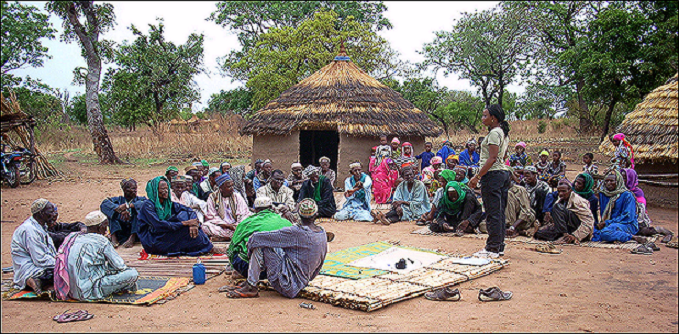Time zone WAT (UTC+1) | Area 26,242 km² | |
 | ||
Alibori is the largest and northernmost département of Benin. The départment borders the countries of Burkina Faso, Niger, and Nigeria. The départments of Atakora and Borgou also border Alibori. The département of Alibori was created in 1999 when it was split off from Borgou Department. Since 2008, the capital has been Kandi.
Contents
Map of Alibori, Benin
Per 2013 census, the total population of the department was 867,463 with 431,357 males and 436,106 females. The proportion of women was 50.30 per cent. The total rural population was 75.70 percent, while the urban population was 24.30 per cent. The total labour force in the department was 201,622 out of which 25.40 per cent were women. The proportion of households with no level of education was 83.70.
Geography
Benin is located in West Africa, bordered by Togo, Niger, Burkina Faso and Nigeria. The northeast region is fertile with highland and savannah. Cotton, corn and cassava are the major crops in the country. The northeast plains slope down to the valleys of Niger river. The climate is usually humid and tropical. The northern regions of Benin, in general, receive one season of rainfall from May to September, compared to the southern regions which receive two spells from March to July and September to November. Harmattan winds blow from northeast during the months of December to March. The relief of the areas of the Department are generally plain embedded with various valleys like Mekrou Valley, Alibori Valley and Pako Valley, which are located in the Niger Plateau. The average maximum temperature in the department is experienced from April to June when it reaches 40 °C (104 °F), while the average minimum temperature between 12 °C (54 °F) to 25 °C (77 °F) is observed during November to March. The average elevation of the department is 200 m (660 ft) above the mean sea level.
Demographics
Per 2013 census, the total population of the department was 867,463 with 431,357 males and 436,106 females. The proportion of women was 50.30 per cent. The total rural population was 75.70 percent, while the urban population was 24.30 per cent. The proportion of women in child bearing age of 15 to 49 years was 22.00 per cent. The total foreign population in the department was 28,636 which formed 3.30 per cent of the total population in the department. The proportion of assets of foreigners aged 10+ years was 27.40 per cent, while for the people aged 15–64 years, it was 26.40 per cent. The proportion of women in foreign population constituted 47.60 per cent. The number of households in the department was 108,351 and the average household size was 8. The intercensal growth rate of population was 4.60 per cent.
The average age of women during first marriage in the department was 27.2 and the average age at maternity was ALIBORI. The synthetic index of fertility of women was 5.7. The average number of kernels in a house was 1.7 and the average number of persons in a room was 2.0. The total labour force in the department was 201,622 out of which 25.40 per cent were women. The proportion of households with no level of education was 83.70 and the proportion of households with children attending school was 23.00. The crude birth rate was 40.9, general rate of fertility was 185.90 and the gross reproduction rate was 2.80.
Administrative divisions
Alibori is subdivided into six communes, each centered at one of the principal towns, namely, Banikoara, Gogounou, Kandi, Karimama, Malanville and Ségbana. Benin, formerly known as Dahomey, was a French colony till 1894. It gained independence during 1960 and was admitted to the United Nations. From 1960 to 1972, there was political instability with frequent change of leadership. Major Mathieu Kerekou seized power in 1972 and remained President until he was overthrown in 1991.
Benin originally had six administrative divisions, but was further bifurcated to make it 12. Each de-concentrated administrative services, called directions départementales(DD) of the sectoral ministries, take care of two administrative regions. A law passed during 1999 empowered the territorial administration to local governments. The département of Alibori was created in 1999 when it was split off from Borgou Department. Since 2008, the capital has been Kandi. Municipalities and communal councils have elected representatives who manage the administration of the regions. The latest elections of the municipal and communal councils were held during June 2015.
